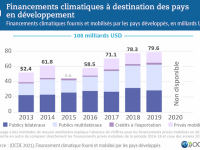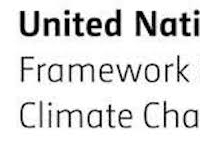Business
STATEMENT BY MATHIAS CORMANN SECRETARY GENERAL OF THE OECD ON CLIMATE FINANCE
$Bn79.6 MOBILISED IN 2019

Mathias Cormann, Sec General OECD (Source: OECD)
USPA NEWS -
Climate finance provided and mobilized by developed countries for developing countries totaled 79.6 billion USD in 2019, an increase of 2% compared to 78.3 billion in 2018, according to new figures from the OECD. This slight increase is explained by an increase in public climate finance provided by multilateral institutions, while bilateral public climate finance commitments have declined, as has climate finance mobilized from private sources. Climate Finance Provided and Mobilized by Developed Countries: Aggregate Trends Updated with 2019 Data is the OECD's fourth assessment of progress towards meeting the UNFCCC target of mobilizing USD 100 billion by year by 2020 to help developing countries cope with and adapt to climate change. "Climate finance continued to grow in 2019, but developed countries still need $ 20 billion to reach the mobilization target of $ 100 billion in 2020," said Mathias Cormann, Secretary-General of the OECD.
Climate finance provided and mobilized by developed countries for developing countries totaled 79.6 billion USD in 2019, an increase of 2% compared to 78.3 billion in 2018, according to new figures from the OECD. This slight increase is explained by an increase in public climate finance provided by multilateral institutions, while bilateral public climate finance commitments have declined, as has climate finance mobilized from private sources. Climate Finance Provided and Mobilized by Developed Countries: Aggregate Trends Updated with 2019 Data is the OECD's fourth assessment of progress towards meeting the UNFCCC target of mobilizing USD 100 billion by year by 2020 to help developing countries cope with and adapt to climate change--------------------------------------------------------------------------------------------------------------------------
"Climate finance continued to grow in 2019, but developed countries still need $ 20 billion to reach the mobilization target of $ 100 billion in 2020," said Mathias Cormann, Secretary-General of the OECD.-------------------------------------------------------
“The limited progress in global volumes of climate finance between 2018 and 2019 is disappointing, particularly in the run-up to COP26. Although properly verified data for 2020 will not be available until early next year, it is very likely that climate finance will remain well below its target. More needs to be done. We know donor countries are recognizing this with Canada and Germany now advancing an implementation plan to mobilize the additional funding needed to reach the target of $ 100 billion per year. "The report finds that public climate finance in developed countries reached US $ 62.9 billion in 2019. Bilateral public climate finance represented US $ 28.8 billion, down 10% from 2018, and multilateral public climate finance allocated to developed countries represented 34.1 billion USD, up 15% compared to 2018. The level of private climate finance mobilized fell by 4%, to 14.0 billion USD in 2019, against 14.6 billion USD in 2018. Climate-related export credits remained low at USD 2.6 billion, representing only 3% of total climate finance.-------------------------------------------------------
The report also shows that of all climate finance in 2019, 25% went to climate change adaptation (up from 21% in 2018), 64% to climate change mitigation activities (up from 70% in 2019). ), and the rest to transversal activities. More than half of total climate finance has targeted economic infrastructure - mainly energy and transport - and most of the rest has gone to agriculture and social infrastructure, including water and sanitation. Asia was the main beneficiary of climate finance over the period 2016-19 with 43% of the total on average, followed by Africa (26%) and the Americas (17%). While climate finance for Least Developed Countries (LDCs) increased sharply in 2019 (+ 27% compared to 2018), funding for Small Island Developing States (SIDS) fell back to 2017 levels (from 2.1 billion USD to 1.5 billion USD) after an increase in 2018.
These data confirm that SIDS face specific challenges in accessing climate finance. The international community needs to consider climate finance that is responsive to the challenges facing SIDS, less fragmented, easier to access, predictable and long-term. Mr Cormann emphasizes: “It is more urgent than ever that developed countries step up their efforts to provide finance for climate action in developing countries, in particular to help poor and vulnerable countries build their resilience to climate change. to the increasing impacts of climate change. " Regarding public financing instruments, grants jumped 30% compared to 2018 to reach USD 16.7 billion in 2019, after remaining stable for the previous three years. In contrast, the volume of public loans, which had increased sharply until 2018, decreased by 5% in 2019. As a result, the share of grants in overall public climate finance was 27% in 2019, while loans (concessional and non-concessional) accounted for 71%.
At the 15th Conference of the Parties (COP15) of the UNFCCC in Copenhagen in 2009, developed countries committed to a collective goal of mobilizing USD 100 billion per year by 2020 for climate action in developing countries . This objective was formalized at COP16 in Cancun, and, at COP21 in Paris, it was reiterated and extended until 2025.
At the request of donor countries, the OECD produces a regular analysis of the progress made in achieving this target, on the basis of a solid accounting framework, in line with the outcome of the COP24 approved by all parties to the Agreement. Paris regarding sources of funding and financial instruments. The OECD figures take into account four distinct components of climate finance provided and mobilized by developed countries: bilateral public climate finance, multilateral public climate finance allocated to developed countries, climate-related export credits benefiting from climate change. '' public support, and private finance mobilized by bilateral and multilateral public climate finance, allocated to developed countries.
Due to the official reporting deadlines for the different datasets, data for 2020 will not be available until 2022. At that point, an in-depth analysis will be conducted to shed light on the period to 2025 as well as to observe to what extent the COVID-19 crisis may have affected climate finance flows. For now, this report adds 2019 to the 2013-18 series, while taking into account data on US bilateral public climate finance for 2018. This data was not previously available and was estimated at the average level of finance. US bilateral climate audience on 2016-17. Actual US bilateral public climate finance in 2018 is $ 0.6 billion lower than this estimate. The year-over-year time series is consistent from 2013 to 2019 for bilateral and multilateral government finance, climate, and export credits. In contrast, data on private climate finance from 2016 is not directly comparable to 2013-14 due to the application of an improved methodology and a resulting gap in the time series in 2015. Cooperating with more than 100 countries, the OECD is an international strategic forum working to promote policies designed to preserve individual freedoms and improve the economic and social well-being of people around the world.
Oecd Mathias Cormann Secretary General Climate Finance Us Secretary Of State Anthony Blinken Anniversary 60th Minister Council Meeting Paris Jedi Foster Rsr
Liability for this article lies with the author, who also holds the copyright. Editorial content from USPA may be quoted on other websites as long as the quote comprises no more than 5% of the entire text, is marked as such and the source is named (via hyperlink).








